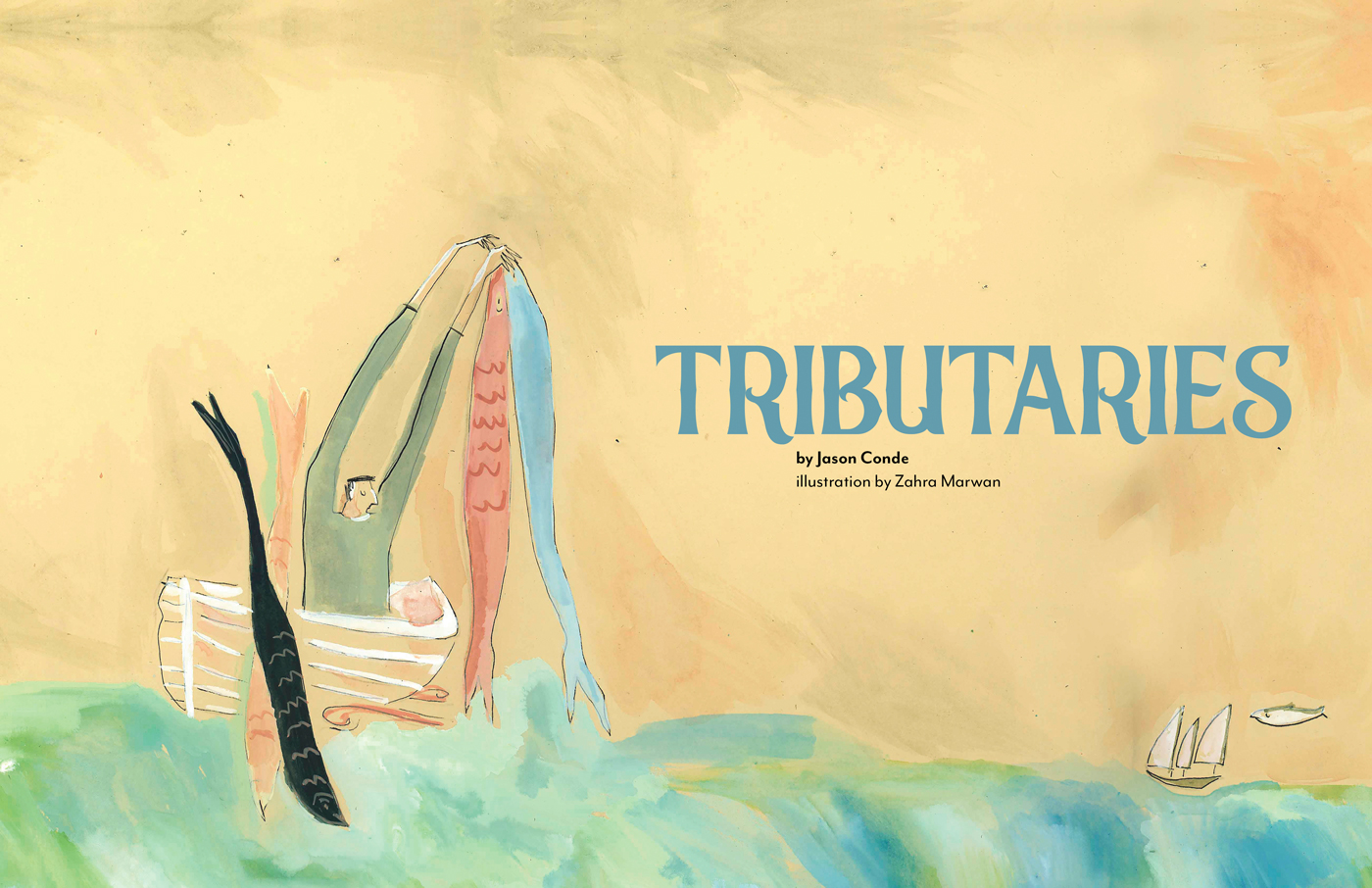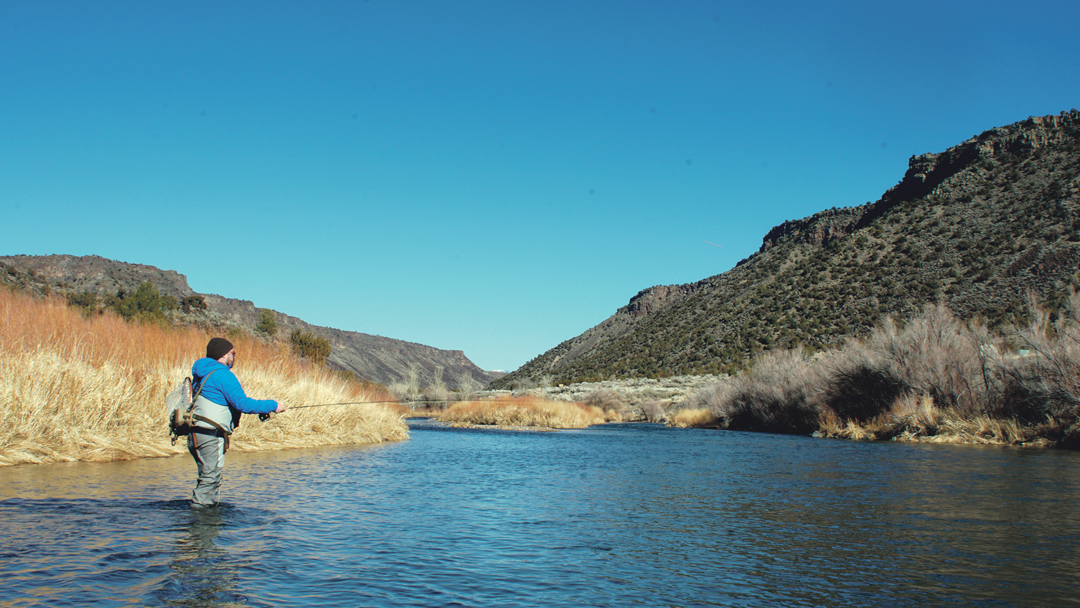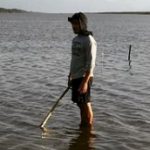
In early January, I met with Sean Sinclair, owner and executive chef of Bar Castañeda in Las Vegas and Legal Tender in Lamy, and his friend Kyle Ruggles, a fishing guide for The Reel Life in Santa Fe, to fly-fish the Rio Grande. Our rendezvous was at 9 am at Michael’s Mini-Mart in Velarde, just north of Española, and from there we drove up NM 570 past Pilar to the Rio Grande Gorge State Park. An early-morning start isn’t necessary midwinter, and by the time we parked, the sun was high, bathing one side of the gorge with bright light while casting the other in snow-covered shadows.
Sean and Kyle have fished their whole lives and both gravitated toward fly-fishing as adults, attracted by the deeper connection to sport and nature that fly-fishing affords. “Rigging your line,” Sean said, securing his wader straps over his shoulders, “reading the water, choosing your fly.”
“Then getting out there and doing whatever you want,” Kyle added.
Kyle and Sean told me that in the winter, the preferred lure is a simple nymph—a weighted, barbless hook with thread coiled around the shaft meant to sink below the water’s surface, where trout root them out along the river bottom while waiting for warmer, insect-abundant months. “January in the Rio Grande,” Kyle said with a smile as we waded waist-deep into forty-degree currents.
~
My dad was born and raised along Manila Bay and survived off tilapia, bream, blue swimming crab, and whatever else he caught with handmade nets, bamboo rods, and hooks and lines made with needles and thread. He raised me and my brothers with more sophisticated tools—spin reels with monofilament line on graphite rods, manufactured nets, barbed hooks, an array of baits and lures, and while we never needed to fish for subsistence, we brought home whatever we caught.
In my last ten years of fishing, I’ve ended up either skunked or catching fish so small they could serve as bait. Nothing on a chartered deep-sea trip where everyone else reeled in arm’s-length lingcod and rockfish. Nothing from the neighborhood pond in my parent’s backyard, where my father and brothers catch and release so many HOA-protected smallmouths they know when they’ve caught the same fish twice. And here in New Mexico, on two occasions with my daughter, our time spent mostly untangling one bird’s nest after another.
~

“How often do you fish for food?” I asked Sean and Kyle as we trudged downriver. They gave each other a look.
“Only when I’m camping,” Kyle said. “But not from the Rio Grande.”
“Most of the fish here are stocked,” Sean said.
“They’re raised in concrete tanks and fed dog kibble,” Kyle said. “You ever been to a hatchery?”
“I have,” I said, and as Kyle and Sean began to tell me about preferring headwater tributaries, I remembered fish hatchery field trips growing up, and the candy dispensers we’d feed quarters into for handfuls of what I thought was fish food. I thought about the stock trout my dad and brothers and I brought home, which my mom baked with soy sauce, lemon, tomato, and scallions and topped with salt, pepper, and fried garlic.
Further downriver, I asked Sean if, for him, there were any connections between cooking and fly-fishing. “Honestly,” Sean said, “fishing is so different from being in restaurants. It’s relaxing. That’s why I come out.” I understood what Sean was trying to say. That’s what I love about fishing—not necessarily the fish but just being outside. My dad, who is retired in Florida, no longer needs to fish for food, but he’s out there every day, and while he comes home with blue crab, shrimp, or sea trout, he’s not in it solely for the catch.
~
In college, I took an elective forestry course—Wilderness and Leisure—that included a unit on fly-fishing. We learned how, in the Mountain West, fly-fishing was linked to industrialization and imperialism, devastating natural ecosystems and native fish populations through the construction of dams and the introduction of invasive, nonnative rainbow and brown trout. The professor mentioned the views of fly-fishers as bug puppeteers and of bait fishers as fish snaggers. We covered fly-fishing’s spiritual associations, the efforts intended to restore natural environments and native fish species, and how race, class, and gender often determined who fished where, with what quality of tackle, and for what sort of fish.
Around the same time, my older brother bought a fly-fishing rod. He practiced casting in our backyard, whipping the yellow line between the shed and our cherry tree. I knew by then I wasn’t a dedicated angler, and what I found out about fly-fishing didn’t help, but I didn’t say anything to my brother about what I’d learned. Some other time, I thought, but his fly-fishing phase didn’t stick. “Spin reels are fine,” my brother explained.
~
With no luck at the state park, we drove south to the Rio Arriba / Taos County Line. Along our walk to the water, which by then felt like I was on with old friends, Sean asked Kyle what happens when clients get skunked. “They don’t,” Kyle said.
The knee-deep water was fast and rocky. Kyle worked his way upriver, singing, “Here, fishy fishy fishy” as he cast his line, while Sean and I talked about restaurant life: the peripatetic pace, the camaraderie, the thick skin developed after years in the industry.
Upriver, we caught up with Kyle, who had his line rigged to his rod like he was ready to go.
“There’s got to be a hundred proverbs for days like this,” Sean said.
My favorite: Looking for fish? Don’t climb a tree.
“It’s because of me,” I said.
“Oh, it was you,” Sean replied, as if he knew exactly what I was talking about. “Should’ve known.”
I shrugged. “But it was nice being out here.”

Jason Conde
Jason Condeis a writer and educator. He lives in Las Vegas, New Mexico, with his partner and their daughter.


